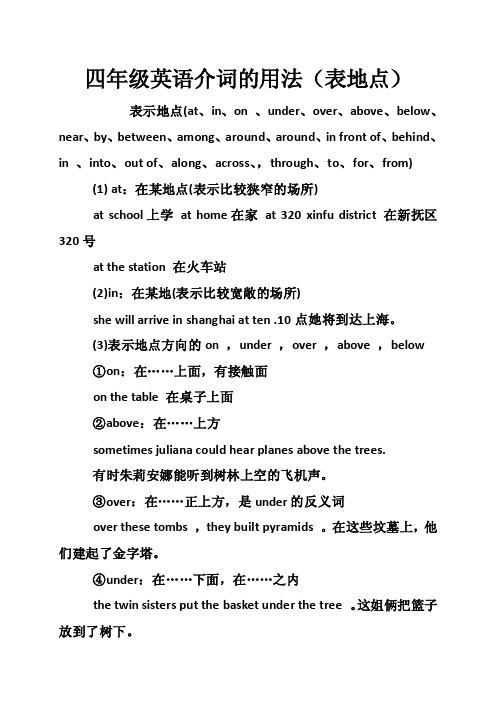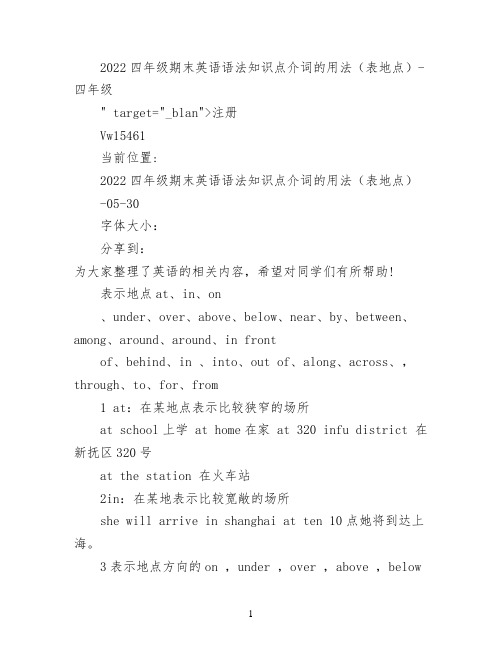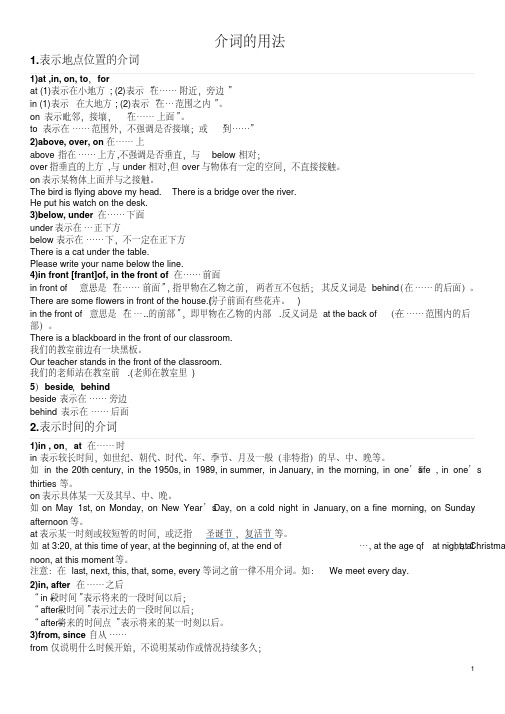四年级英语介词的用法(表示地点)
- 格式:doc
- 大小:25.00 KB
- 文档页数:2

四年级英语介词的用法(表地点)表示地点(at、in、on 、under、over、above、below、near、by、between、among、around、around、in front of、behind、in 、into、out of、along、across、,through、to、for、from)(1) at:在某地点(表示比较狭窄的场所)at school上学at home在家at 320 xinfu district 在新抚区320号at the station 在火车站(2)in:在某地(表示比较宽敞的场所)she will arrive in shanghai at ten .10点她将到达上海。
(3)表示地点方向的on ,under ,over ,above ,below①on:在……上面,有接触面on the table 在桌子上面②above:在……上方sometimes juliana could hear planes above the trees.有时朱莉安娜能听到树林上空的飞机声。
③over:在……正上方,是under的反义词over these tombs ,they built pyramids 。
在这些坟墓上,他们建起了金字塔。
④under:在……下面,在……之内the twin sisters put the basket under the tree 。
这姐俩把篮子放到了树下。
⑤below:在……下方,(不一定是正下方)three thousand metres below her ,she could see nothing except the thick jungle 。
3000米以下,除了茂密的丛林之外,她什么也看不见。
(4)near ,by①near:近的,不远的(=not far)是的反义词,near还可以指时间,in the near future在不远的将来。

介词的使用方法口诀介词是连接名词、代词或动词与其他词语的一种虚词,它在句子中起着非常重要的作用。
正确使用介词不仅可以使语言表达更加准确,而且还可以增强语言的表达能力。
下面就介绍一下介词的使用方法口诀,希望能帮助大家更好地掌握介词的用法。
一、表示地点的介词。
1. in,表示在某个范围内或大的地点,如in the room(在房间里)、in China (在中国)。
2. on,表示在某个表面或小的地点,如on the table(在桌子上)、on the wall (在墙上)。
3. at,表示在某个具体的地点或场所,如at home(在家)、at the station(在车站)。
二、表示时间的介词。
1. in,表示在某个时间段内,如in the morning(在早晨)、in July(在七月份)。
2. on,表示在某一天或日期,如on Monday(在星期一)、on January 1st(在1月1日)。
3. at,表示在某个具体的时间点,如at 3 o'clock(在3点钟)、at noon(在中午)。
三、表示原因的介词。
1. because of,表示由于,引起某种原因,如because of the rain(因为下雨)。
2. due to,表示由于,常用于正式场合,如due to the bad weather(由于恶劣的天气)。
四、表示方式的介词。
1. by,表示通过某种方式或手段,如by bus(乘坐公交车)、by email(通过电子邮件)。
2. with,表示伴随或使用某种方式,如with a smile(带着微笑)、with great care(非常小心地)。
五、表示比较的介词。
1. than,用于比较级句式中,表示比较的对象,如taller than me(比我高)。
2. as,用于肯定句中,表示与某人或某物相同,如as tall as me(和我一样高)。
六、其他常用介词。

介词in,at,on的用法一、in, at, on的基本用法介词in,at,on是英语中常见的介词,它们在句子中起着连接名词或名词短语与其他成分的作用。
尽管它们看似简单,但其用法却有一些细微的差别,需要我们在使用时加以注意和区分。
I. in的用法1. 表示位于某处:in表示“在……里面”、“在……之中”,常用于指代较大的物体、空间或范围。
例如:- I am in the classroom.(我在教室里。
)- She is in France.(她在法国。
)2. 表示时间:in表示“在……时候”、“在……期间”,常用于表示年、季节、月份等。
例如:- We go swimming in summer.(夏天我们去游泳。
)- My birthday is in December.(我的生日是十二月份。
)3. 表示附加状态:in表示“处于某种状态”、“身处某种情况”,通常后面接复合结构。
例如:- He is in a bad mood today.(他今天心情不好。
)- The company is in financial trouble.(公司陷入了财务困境。
)II. at的用法1. 表示位置:at表示“在……地方”、“在某处”,常用于指代较小范围的地点、位置或具体场所。
例如:- She is waiting for you at the bus stop.(她在公交车站等你。
)- I will meet you at the cinema.(我会在电影院见你。
)2. 表示时间:at表示“在……具体时间点”,通常用于某一具体时刻、钟点或时间段。
例如:- The meeting starts at 9 a.m.(会议在上午九点开始。
)- I usually have dinner at 6:30 p.m.(我通常六点半吃晚饭。
)3. 表示动作进行的状态:at表示“正在进行某个动作”、“忙着做某事”,通常用于表示举止、动作进行中。

2022四年级期末英语语法知识点介词的用法(表地点)-四年级
" target="_blan">注册
Vw15461
当前位置:
2022四年级期末英语语法知识点介词的用法(表地点)
-05-30
字体大小:
分享到:
为大家整理了英语的相关内容,希望对同学们有所帮助!
表示地点at、in、on
、under、over、above、below、near、by、between、among、around、around、in front
of、behind、in 、into、out of、along、across、,through、to、for、from
1 at:在某地点表示比较狭窄的场所
at school上学 at home在家 at 320 infu district 在新抚区320号
at the station 在火车站
2in:在某地表示比较宽敞的场所
she will arrive in shanghai at ten 10点她将到达上海。
3表示地点方向的on ,under ,over ,above ,below
①on:在……上面,有接触面
on the table 在桌子上面
②a bove:在……上方
sometimes juliana could hear e ,go ,wal ,jumes here for 你知道他为什么来这儿吗
③from:从……地点起
how far is it from london to new yor从伦敦到纽约有多远。

小学的归纳与解析常见介词的用法和搭配规则介词在英语语法中扮演着重要的角色,它用于表示名词、代词、动词或形容词和其他短语等之间的关系。
介词的正确使用对于英语学习者来说是至关重要的。
本文将归纳并解析小学阶段常见的介词用法和搭配规则,帮助学生掌握基本的介词用法。
一、表示地点的介词1. in介词"in"常用于表示在某个里面、范围、地方或国家等,例如:- 我住在一个小村庄里。
I live in a small village.- 她在商店里买了一本书。
She bought a book in the store.2. on介词"on"常用于表示在某个平面、表面或位置上,例如:- 她放了一个杯子在桌子上。
She put a cup on the table.- 小狗躺在地板上。
The puppy is lying on the floor.3. at介词"at"常用于表示在某个具体点、地方或事件中,例如:- 我们在学校的门口等你。
We are waiting for you at the school gate.- 她在图书馆参加了一个讲座。
She attended a lecture at the library.二、表示时间的介词1. in介词"in"常用于表示在某个时间段或月份中,例如:- 我在冬天喜欢滑雪。
I enjoy skiing in winter.- 我们将在十二月举办一次聚会。
We will have a party in December.2. on介词"on"常用于表示在某个具体日期或星期几,例如:- 他们将在星期五晚上去看电影。
They will go to the movies on Friday night.- 我的生日是在七月二十一日。
My birthday is on July 21st.3. at介词"at"常用于表示在某个具体时间点,例如:- 晚上九点钟我会在家里等你。

介词的用法1.表示地点位置的介词1)at ,in, on, to,forat (1)表示在小地方; (2)表示“在……附近,旁边”in (1)表示在大地方; (2)表示“在…范围之内”。
on 表示毗邻,接壤,“在……上面”。
to 表示在……范围外,不强调是否接壤;或“到……”2)above, over, on 在……上above 指在……上方,不强调是否垂直,与below相对;over指垂直的上方,与under相对,但over与物体有一定的空间,不直接接触。
on表示某物体上面并与之接触。
The bird is flying above my head. There is a bridge over the river.He put his watch on the desk.3)below, under 在……下面under表示在…正下方below表示在……下,不一定在正下方There is a cat under the table.Please write your name below the line.4)in front [frant]of, in the front of在……前面意思是“在……前面”,指甲物在乙物之前,两者互不包括;其反义词是behind(在……的后面)。
in front of…There are some flowers in front of the house.(房子前面有些花卉。
)in the front of 意思是“在…..的前部”,即甲物在乙物的内部.反义词是at the back of…(在……范围内的后部)。
There is a blackboard in the front of our classroom.我们的教室前边有一块黑板。
Our teacher stands in the front of the classroom.我们的老师站在教室前.(老师在教室里)5)beside,behindbeside 表示在……旁边behind 表示在……后面2.表示时间的介词1)in , on,at 在……时in表示较长时间,如世纪、朝代、时代、年、季节、月及一般(非特指)的早、中、晚等。
快速掌握地点介词In、on、at的方法快速掌握地点介词 In、On、At 的方法在英语中,地点介词是用来描述事物或人所在位置关系的词汇。
本文将为您详细介绍如何快速掌握这三个常用的地点介词:in、on、at。
一、介词 In 的用法1. 表示在某个范围内- I live in Beijing. (我住在北京。
)- There is a book in the bag. (书包里有一本书。
)2. 表示在某物体内部- There is water in the bottle. (瓶子里有水。
)- She is in the room. (她在房间里。
)二、介词 On 的用法1. 表示在某物体的表面上- There is a book on the table. (桌子上有一本书。
)- He put the cake on the plate. (他把蛋糕放在盘子上。
)2. 表示在某物体上部- There is a cat on the roof. (屋顶上有一只猫。
)三、介词 At 的用法1. 表示在某个特定点上- I will meet you at the airport. (我在机场等你。
)- She lives at No. 10 Downing Street. (她住在唐宁街10号。
)2. 表示时间点- I will call you at 8 o'clock. (我在8点给你打电话。
)总结通过以上详细解析,我们可以总结出:- In用于表示在某范围内或某物体内部。
- On用于表示在某物体的表面或上部。
- At用于表示某个特定点或时间点。
希望这份文档能帮助您快速掌握这三个地点介词的用法。
在日常英语交流中,灵活运用这些介词,能够更准确地描述事物或人的位置关系。
小学英语常用介词用法在学习英语的过程中,掌握介词的正确用法是非常重要的。
介词是连接词与词之间关系的一种词类,它能够表示时间、地点、方式、原因等等。
在小学英语中,常用的介词有很多,下面将为大家介绍一些常用的介词及其用法。
1. in介词"in"用于表示在某个范围内或在某个具体的位置上。
例如:- I live in a house.- There is a book in the bag.2. on介词"on"用于表示在某个表面上。
例如:- The cup is on the table.- The picture is on the wall.3. at介词"at"用于表示在某个点、位置或地方。
例如:- He is waiting at the bus stop.- We will meet at the park.4. by介词"by"用于表示通过某种方式或手段。
例如:- I go to school by bus.- They communicate by email.5. for介词"for"用于表示目的、原因或表示给予的对象。
例如:- This gift is for you.- I study hard for good grades.6. with介词"with"用于表示陪伴或伴随的状态。
例如:- She went to the park with her friends.- He plays basketball with his brother.7. to介词"to"用于表示目的、方向、接触等。
例如:- I go to school every day.- She gives a present to her teacher.8. from介词"from"用于表示出发地、来源或起点。
介词的使用方法口诀介词是英语中非常重要的一部分,它可以用来表示时间、地点、方向、原因等,正确使用介词可以让句子更加准确和流畅。
下面就是一些关于介词使用方法的口诀,希望对大家有所帮助。
一、表示时间。
介词in用于年、月、季节、上午、下午、晚上等时间段;介词on用于具体的某一天或日期;介词at用于具体的某一时刻或节日。
二、表示地点。
介词in用于表示大的范围或封闭的空间;介词on用于表示平面或表面;介词at用于表示具体的位置或建筑物。
三、表示方向。
介词to表示朝向某个地方或目的地;介词from表示从某个地方出发;介词across表示横穿过某个地方;介词towards表示朝向某个方向。
四、表示原因。
介词because of用于表示肯定的原因;介词due to用于表示中性的原因;介词owing to用于表示正式的原因;介词thanks to用于表示积极的原因。
五、其他常用介词。
介词by表示通过某种方式或工具;介词with表示伴随或使用某物;介词for表示为了某种目的或代表某人。
六、特殊用法。
介词in、on、at在特定搭配中有特殊用法,需要根据具体情况进行记忆和理解。
七、总结。
介词的使用方法口诀并非一成不变,需要根据具体语境进行灵活运用。
通过大量的阅读和实践,逐渐掌握介词的用法是非常重要的。
以上就是介词的使用方法口诀,希望对大家有所帮助。
在学习英语的过程中,多多积累、多多练习,相信大家一定能够掌握好介词的使用方法,写出更加地道和流畅的英语句子。
语法|英语介词知识点用法总结!1.In(在,表示时间、地点、状态):- 表示具体的时间点或时间段:in the morning(早晨)、in May(五月)、in 2024(2024年)- 表示地点:in the park(在公园里)、in London(在伦敦)- 表示状态:in trouble(陷入困境)、in love(恋爱中)2.On(在,表示时间、地点、表面):- 表示具体的日期或星期几:on Monday(星期一)、on December25th(12月25日)- 表示地点:on the bus(在公交车上)、on Main Street(在主街上)- 表示表面:on the table(在桌子上)3.At(在,表示时间、地点):- 表示具体的时间:at 8 o'clock(在8点钟)、at noon(在中午)- 表示地点:at the cinema(在电影院)、at home(在家)4.To(到,表示方向或目的地):- 表示目的地:a trip to Paris(巴黎之行)、a letter to John (写给约翰的信)- 表示出发地:a flight from New York(从纽约起飞的航班)、a train from London(从伦敦开出的火车)- 表示原因:suffer from a cold(患感冒)6. For(为了,表示目的、受益人):- 表示目的:study for the exam(为考试而学习)、buy flowers for my mother(给母亲买花)- 表示受益人:a gift for you(给你的礼物)7. With(和,表示伴随、使用、具备):- 表示伴随:go shopping with friends(和朋友一起购物)、have dinner with family(和家人一起吃晚饭)- 表示使用:write with a pen(用钢笔写)- 表示具备:a girl with long hair(一位长发的女孩)以上是一些常见的英语介词及其用法总结,介词在句子中使用灵活多样,需要根据具体语境来选择适当的介词。
四年级英语介词的用法(表示地点)
表示地点(at、in、on 、under、over、above、below、near、by、between、among、around、around、in front of、behind、in 、into、out of、along、across、,through、to、for、from)
(1) at:在某地点(表示比较狭窄的场所)
at school上学at home在家at 320 xinfu district 在新抚区320号
at the station 在火车站
(2)in:在某地(表示比较宽敞的场所)
she will arrive in shanghai at ten .10点她将到达上海。
(3)表示地点方向的on ,under ,over ,above ,below
①on:在……上面,有接触面
on the table 在桌子上面
②above:在……上方
sometimes juliana could hear planes above the trees.
有时朱莉安娜能听到树林上空的飞机声。
③over:在……正上方,是under的反义词
over these tombs ,they built pyramids 。
在这些坟墓上,他们建起了金字塔。
④under:在……下面,在……之内
the twin sisters put the basket under the tree 。
这姐俩把篮子放到了树下。
⑤below:在……下方,(不一定是正下方)
three thousand metres below her ,she could see nothing except the thick jungle 。
3000米以下,除了茂密的丛林之外,她什么也看不见。
(4)near ,by
①near:近的,不远的(=not far)是的反义词,near还可以指时间,in the near future在不远的将来。
green’s lake was a small lake near his home 。
格林湖是他家附近的一个小湖。
②by:在……旁边,比的距离要近
juliana walked by the side of the river for six more long days 。
朱莉安娜沿着河岸又走了足足6天。
(5)between ,among ,around
①between:在两者之间
the differences between american english and british english are not very great 。
美国英语和英国英语之间的差别不是很大。
②among:在三者或者更多的之中
there are some american students among us 。
在我们中间有几个美国学校。
③around:环绕,在…。
的周围,在……的四周
they arrived at a valley with high mountains all around it 。
他们到达了四周有高山环绕的山谷
(6)in front of ,behind
①in front of :在……的前面
there is a car in front of the house 。
房子前面有一辆小汽车。
②behind :在…。
后边
are there any cows behind the house ?房子后面有一些牛吗?
(7)in ,into ,out of
①in:在…。
之内,用于表示静止的位置
there are four girls in the room.房间里有4个女孩。
②into:进入,用于表示有特定终点的运动方向,通常用于表示动作的动作之后。
如:come ,go ,walk ,jump ,run.。
she took me from the hall into my classroom 。
她把我从门厅带进我的教室里边去。
(8)along ,across ,through
①along:沿着
go along zhongshan road and turn right at the second crossing 。
沿着中山路走然后在第二个十这路口向右拐。
②across:横过(平面物体)
very slowly,the continents are moving across the face of the world 。
各个洲在地球表面缓缓漂移。
③through:贯通,通过
the students walked through the gate with uncle wang 。
学生们随着王叔叔通过大门。
(9)to ,for ,from
①到达……地点(目的地)或方向
where’s jack? he has gone to london.杰克上哪了?他去伦敦了。
②for:表示目的,为了……
do you know what he comes here for ? 你知道他为什么来这儿吗?
③from:从……地点起
how far is it from london to new york? 从伦敦到纽约有多远?。